Gae Polisner's Blog, page 2
September 11, 2020
We All Need to Be Kinder
Since THE MEMORY OF THINGS came out, I've been talking about 9/11 -- an unwitting emotional "expert" of sorts, by way of the research I did, and the story I told.

I believe my novel -- and others' stories -- on this subject are essential, because kids in desks, K-12, weren't even alive when our country was changed forever that impossibly sunny blue-skied day. They have as little feel for 9/11 and its aftereffects as I had for WWII when I was in school. They don't get it, and they don't care.
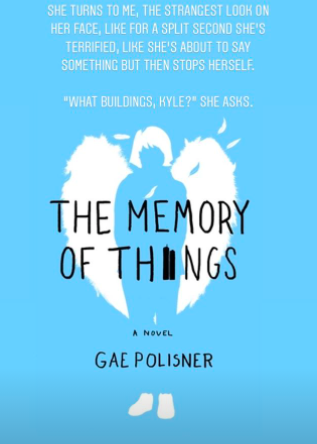
Science has shown that reading literary fiction builds empathy. Just last night, I had a message from a 15-year-old boy in Indiana -- I'll call him C here -- who read my book for school, and something resonated, something clicked. He is going through a rough time.
"I'm a student of [omitted for privacy reasons]," he tweeted to me, "and I would like to say I loved the book were reading in our class i read ahead and finished it and they recommended talking to u. I loved the book wich [sic] is odd because I never read books but I must say that is one of my favorite books."
We exchanged messages for about an hour. About music, about his recent breakup, about life. I offered to send him a signed copy of my book, and a few of my other titles. I just got back from the post office. "We need more kind people," he wrote to me.
Indeed, we do.

There are hashtags and sayings forever associated with 9/11: We're all in this together. #neverforget.
But are we? Have we?
We have a virus -- a pandemic in this country-- that has already killed nearly 200,000 people. Science and medicine have told us masks help. Masks work. Distancing works. And yet, day after day we are flooded with images of those who refuse to even try to help. Worse, those who harm those who try to help.
I know not everything after 9/11 was peace, love and harmony, that Islamophobia and conspiracy theories arose, that here and there, looters took advantage.


But mostly, there was an overwhelming sense of shared historic grief, a sense of urgent connection. A sense we were responsible not only for ourselves, but one another.
On a small scale, we've sure seen that since March. In our healthcare workers, our essential workers, and our educators, now, who continue to put their lives on the line for us every single day. But as a nation? It's heartbreaking, and I can't help ask myself the rhetorical question: What has changed?
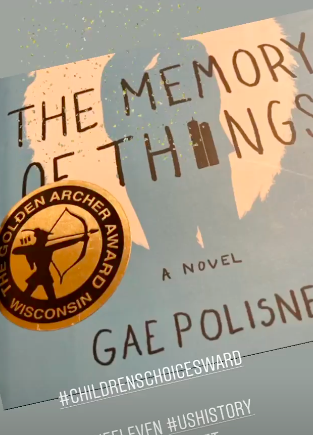
Not everything is political. The fate of our neighbors, our friends, the fate of strangers, all matter.
We are all human. Our kids need us to rally TOGETHER. Not for a political party but for humanity.
Our healthcare and essential workers need us.
Our educators need us.
That boy, C? He reminded me of another male student, this one I'll call M, from Kansas, I "met" via my book a few years back who I stayed in touch with simply because of a story. My story about 9/11, and a time our country was in trouble. And we all came together. A story about one kid who finds his way through grief to cope, and in doing so, learns how to step up and be a better person. That boy, M, just messaged me two nights ago to tell me he graduated high school and is headed off to the marines.
"Wow, congrats! That's hard," I wrote. "You must be proud. And brave." We messaged on for a bit and soon enough I wrote my heart: "Please find a way to be tough. . . and also kind and accepting. A hard juggle."
"I will," M responded with a purple heart. "Thank you."
#NeverForget #WeAreSTILLAllInThisTogether #Nineeleven #Kindness #SharedHistory #literaryfictionbuildsempathy
June 15, 2020
Book Releases in the Time of Covid (and a Few Clues to Reader Love)
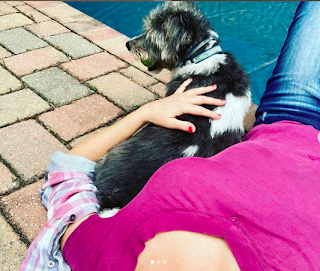 I've spent a lot of time lying on the ground these past months, lying where I'm planted.
I've spent a lot of time lying on the ground these past months, lying where I'm planted. Maybe it's metaphorical.
Maybe I'm just exhausted like many of us, from the constant upheaval, both political and pandemical.
If that's not a word, it really should be.
I, myself, live here in NY on LI, a hot spot. In fact the hottest of the hotspots, in a way you never wanted to win that title. And I've spent most of it sick with an undiagnosed respiratory thing that seemed sprung from a 24-hour virus the first week in March...
For sure, it's taken a toll on me. I've aged several years in these past few months. I know many of you will nod along.
As much as we've all suffered, I can't help feel that, much like after 9/11, those of us in NY and NJ have lived through something slightly (or majorly) different than the rest of you. For months, the world here was out of a sci fi movie (and still is), empty and quiet and terrifying, everything shut down but essential workers.
Doctor friends told horror stories. They slept away from their families. Pop up ICU's filled formerly public spaces. Our daily death numbers were in the thousands. Now as the virus spread has finally slowed and states have begun to open back up, I don't take any of it lightly. My kids are still here. My parents are still here! My friends are still here. And I'm finally starting to feel better myself.
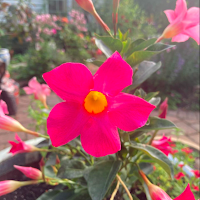
And yet, people close to me were not that lucky. People close to me have lost their people. Mothers and fathers, brothers and sisters, husbands and friends. My sons have lost icons, people in their prime who shouldn't have been cut down. And don't get me started on the rest of the news. . .
As the country opens up, so much of it carelessly, I don't know how many of us here in NY feel capable of weathering another round.
And yet.
In the middle of it, some silver linings. Here in the northeast, spring sprung. The environment has rebounded some. People have taken to the streets in record numbers to decry ongoing police brutality and blatant racism.
 My son in the rainbow mask at a local protest.
My son in the rainbow mask at a local protest. 
The open water swim season has begun, and I feel well enough to finally swim.
In the middle of all of that, I had not one but two book releases. Maybe I don't have to tell you how hard it is to be a midlist author releasing books into a covid/quarantine abyss.
I write literary young adult (and now middle grade!) fiction. School/library is my most supportive audience (and purchaser). Yet these books came out to a nation of closed libraries and booksellers.
It hasn't been pretty. JACK KEROUAC IS DEAD TO ME, a book I worked on for over the course of a decade, came out in early April as EVERYTHING shut down. Few library districts have picked it up. Few non-trade reviewers even covered it. SEVEN CLUES TO HOME came out in the midst of protests and unrest on the day of George Floyd's funeral. Even the best self promoter with the most hardened heart would be hard pressed to shout out their books in the middle of these far greater things that need our attention.
And yet.
And yet.
This is my career. My livelihood.
And barely at that.
Like many of us, I have been struggling to find both balance and salvation. Like many of us, I have been struggling to make sense, struggling to map a future, struggling to do better in a world that often seems to tell me my better will never be enough. When I'm already pretty damned good at telling myself that.
But even in the book biz, there have been silver linings. Our local Barnes and Noble just opened and I decided to stop in, trying to brace myself for the reality that, by now, JACK KEROUAC IS DEAD TO ME might already be gone from its shelves. If it ever even found its way there in the first place.
Instead, I found it here:
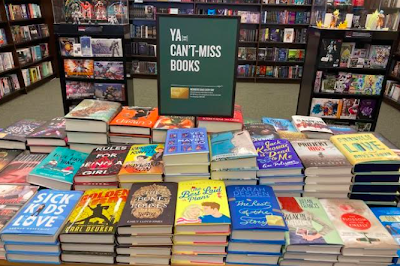 It took me five books to find one of my titles displayed with the big names like this.
It took me five books to find one of my titles displayed with the big names like this.And SEVEN CLUES TO HOME has gotten some incredible reviews including Booklist who called it a "modern-day Bridge to Terebithia" and Kirkus who called it a "heartfelt tour de force."
You can see (and share!) the official trailer for the book here: https://www.youtube.com/watch?v=TDtj4EegDZA
If you are a parent, educator or a librarian reading, my co-writer Nora and I have been doing a ton of work to connect young readers not only to the story but to the outside world around them. In an age of physical distancing, we've created a bunch of fun activities, our favorite, a series of book-related mini-scavenger hunts we hope our readers enjoy.
I'll share the hunts below. And, remember, the point of these hunts is to have fun! Creativity, fresh air, and flexibility are encouraged, perfection, not so much.
So, for example, if it says to find a dolphin or peacock, they don’t have to be live ones -- though big kudos if they are! Instead, they can be paintings of them, or versions embroidered on a pillow, or even clouds shaped like one!
 Hunt #1: A QUICK SLICE Find and take a photo of each of the following items (it’s okay to be creative!):
Hunt #1: A QUICK SLICE Find and take a photo of each of the following items (it’s okay to be creative!):
A white envelope with a name on it;A guitar;A pizza parlor;Carved words or numbers in wood;A dolphinA pie (or pi).
 Hunt #2: BE THRIFTY Find and take a photo of each of the following items (it’s okay to be creative!):
Hunt #2: BE THRIFTY Find and take a photo of each of the following items (it’s okay to be creative!):
Something bejeweled or bedazzled;A “so tiny dog that looks like a rat;”An old-fashioned toy that winds up, claps, or spins;A hat with a feather;A peacock . . . or peafowl ;)A constellation.
 Hunt #3: SOMETHING FISHYFind and take a photo of each of the following items (it’s okay to be creative!):
Hunt #3: SOMETHING FISHYFind and take a photo of each of the following items (it’s okay to be creative!):
A tackle box or fishing rod;Someone telling a short, dumb joke (video);A gazebo;A big juicy worm;A heron or other seabird;A lighthouse.
 Hunt #4: CURIOSITY & WONDERS Find and take a photo of each of the following items (it’s okay to be creative!): A painted rock;;A heart-shaped tree;A “whale’s eye” shaped knot in a tree;A bus shelter;Some sort of hole;A rainbow.
Hunt #4: CURIOSITY & WONDERS Find and take a photo of each of the following items (it’s okay to be creative!): A painted rock;;A heart-shaped tree;A “whale’s eye” shaped knot in a tree;A bus shelter;Some sort of hole;A rainbow.
 Hunt #5: CLUES TO HOMEFind and take a photo of each of the following items (it’s okay to be creative!):
Hunt #5: CLUES TO HOMEFind and take a photo of each of the following items (it’s okay to be creative!):
A red box or containerHeart necklace or other heart-shaped jewelry M&Ms, Skittles or other candy you could plant as “seeds” A potted plant - real or artificialA cloud formation that clearly looks like an animal or objectA love note, or handwritten note from a friend.
In fact, I'll run my own personal-three book giveaway here. Through the end of August, if your child reads SEVEN CLUES TO HOME and completes all five mini hunts, have them email me a photo of them holding a copy of the book, as well as photos of the objects they found, and I'll enter them to win a package of three signed copies of my books and a skype/zoom or google hangouts conversation with me (if they want it!). They can email me at g.polisner@gmail.com (if you email and don't get a response without 48 hours, it means your email somehow did not get to me!) They can also tag me on instagram @gaepol and share their scavenger hunt photos there with me! Sending love out to the universe and to all of you, Gae
April 22, 2020
Mental Health & Coping

I'm not a doctor, nor do I play one on TV.
So why do I seemingly so often write about mental health? About characters struggling with mental health?
Because I'm human.
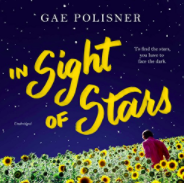
In fact, when IN SIGHT OF STARS, my first book that really centered around one boy's struggle with his mental health/state, got classified (by a publishing INDUSTRY needing to label how to shelve things in a bookstore) as a book about mental illness, it surprised me a little.
I hadn't written a story about a kid with mental illness (nor had I NOT written that story. . . ). I simply wrote a story about a boy -- this boy, Klee -- who had one-too-many hard things pile on him and felt like he couldn't cope anymore.
Who fell apart.
Who broke temporarily.
 And who, then, found a way -- WITH HELP -- to pull himself back together for the time being.
And who, then, found a way -- WITH HELP -- to pull himself back together for the time being. All things I had experienced or witnessed as part of my journey as a human.
In my newest book, JACK KEROUAC IS DEAD TO ME, my main character's mother, most visibly, struggles with her own mental health. Her diagnosis would likely skew toward more definitive mental illness, but she has not yet been fully diagnosed.
In that story, I try to show how hard it can be to get a grasp on some struggles, and how it might affect the child of a parent struggling. But it is without judgment.
My goal is always to give my characters room to suffer, and even to break, and the hope -- and room -- to heal again.
The world is harder than ever (ya think!?!)
Even without a country divided and a pandemic, I believe we all have, or will, face mental health challenges in our lives at one point or another, and the more we talk about our struggles, the more connected we are, and the more able we will be to reach out for help and heal.
That's why my friend, and world's best virtual co-hugger, Cheryl Rainfield, is asking us all to band together tomorrow, Thursday April 23rd, to let others know there is #NoShameInCoping, that it's okay to #ShieldYourMentalHealth, and to #ReachOutToConnect.
 Learn more about Cheryl HERE.You can find more information here: http://cherylrainfield.com/blog/index.php/2020/04/21/the-pandemic-is-traumatizing-join-me-thursday-april-23-in-letting-others-know-there-is-noshameincoping-and-that-its-okay-to-shieldyourmentalhealth-and-to-reachouttoconnect/
Learn more about Cheryl HERE.You can find more information here: http://cherylrainfield.com/blog/index.php/2020/04/21/the-pandemic-is-traumatizing-join-me-thursday-april-23-in-letting-others-know-there-is-noshameincoping-and-that-its-okay-to-shieldyourmentalhealth-and-to-reachouttoconnect/So, let's all #ReachOutToConnect !!!
There is no shame in needing help. There is no stigma in falling apart. There is #NoShameInCoping
And you have every right to #ShieldYourMentalHealth
Please know there are good and skilled people out there who care and want to help. They can and they will.
I know. I've met them.
xox gae
January 29, 2020
A Little Obsessed with Kerouac . . .
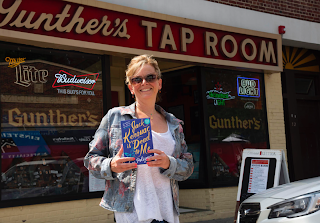 Me, in front of Gunther's Tap Room in Northport, NY
Me, in front of Gunther's Tap Room in Northport, NYlast summer. Photo credit, Rick Kopstein
In the coming weeks before the release of my fifth novel, JACK KEROUAC IS DEAD TO ME, I'm going to share both tidbits about the story and the writing process, and about the eponymous author, Jack Kerouac, himself.Though some will clearly go into my novel wishing to find more about Kerouac, the title should be a bit of a tip off. It is NOT a book about Kerouac. Rather, like me, my MC is not a huge fan of Kerouac's -- though for very different reasons. . . Though Kerouac, himself, does appear in a pivotal scene in the book.
I want to love Kerouac's books more than I do. I've delved back into some of his works, post-writing mine, for this book release. At the moment, I'm slogging through the middle of Big Sur. His writing is inarguably extraordinary. Still, I fall in the school of being, first, breathtakingly enamored with his talent, then grow slightly lost or bored in his ramblings, and find myself craving a bit more hardcore editing.
Having said that, I am fascinated by his life, and the fact that he lived for a while in Northport, NY, very close to where I live, makes him feel all the more real and relevant to me. And the closer I get to my release date, the more I find myself reading him, and drifting around the internet and beyond to catch glimpses of his life. I will share some of that with you in coming weeks.
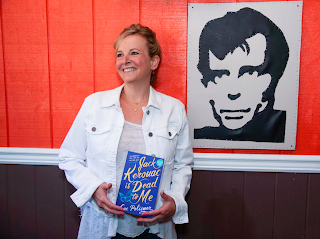 Inside Gunther's Tap Room, in front of the eponymous author.
Inside Gunther's Tap Room, in front of the eponymous author.photo credit, Rick KopsteinNo doubt, Kerouac was both a talent and a tortured human being, never clearer than in this Newsday piece from July 2000 that was covering an exhibition/retrospective being held in that town.From Newsday staff writer Ariella Budick, printed July 13, 2000:EVEN AMONG Beat aficionados, it is a little-known fact that Jack Kerouac spent six years, on and off, in Northport, Long Island.Celebrated during his lifetime as "King of the Beats," Kerouac retreated to a shingled Victorian at 34 Gilbert St. in 1958, the year after the publication of "On the Road."His rapid rise to fame-he was heralded as the gifted spokesman for a disenchanted generation-yielded to an equally precipitous decline that, by the time he moved to Northport, was in full swing. An exhibit at the Northport Historical Society, devoted to Kerouac's sad years in the sleepy village he briefly called home, details the impact the writer made on Northport and the less significant impact Northport seems to have made on him. It is a tightly focused show, designed for two quite specific, and necessarily limited, sets of viewers: Northport history buffs and steadfast Kerouac disciples.Kerouac moved to Northport with his mother, whom he called Memere, the constant companion of his adult life. Memere, conservative and Catholic, thoroughly despised Kerouac's New York friends, whom she judged a noxious influence. She particularly loathed Allen Ginsberg for his Jewishness and his homosexuality, even threatening at one point to report him to the FBI for engaging in anti- American activities. She also sent angry missives to William S. Burroughs, who remarked, "My God! She really has him sewed up like an incision." Indeed, one of Kerouac's reasons for moving to Northport was to put some distance between himself and his cosmopolitan friends.
"By all accounts, Kerouac spent his Northport years in an alcoholic haze, playing pool at neighborhood bars. A series of depressing photos capture him, overweight and falling apart, clowning pathetically for the camera."
By all accounts, Kerouac spent his Northport years in an alcoholic haze, playing pool at neighborhood bars. A series of depressing photos capture him, overweight and falling apart, clowning pathetically for the camera. His inspiration was hopelessly stalled: The many books he brought out during these years were all written earlier, when publishers had been unwilling to consider his work.Even so, Kerouac's presence seems to have made an impact on some young lives. George Wallace, the exhibit's curator, has enshrined testimonials from a small sampling of Northport's (then) youth, attesting to Kerouac's extraordinary influence: "He made me a thinking person," says Carol Watson, who was 15 when she first met the unstable author. Although the exhibition text informs us that Kerouac did not particularly appreciate attentions from fawning young fans, he enthusiastically joined them in juvenile high jinks. One incident, we are told, involved police chasing the aging Beat and a group of young boys out of an abandoned Gold Coast mansion, after which Kerouac fell asleep, drunk, in the woods.Kerouac became increasingly conservative- even xenophobic-as he grew older and more isolated. He rabidly supported the Vietnam War, and his growing disenchantment with erstwhile Beat friends and their "anti-American views" sometimes sounded like paranoia."Somewhere along the line I knew there'd be girls, visions, everything," Kerouac rhapsodized in "On the Road"; "somewhere along the line the pearl would be handed to me." But this sometime son of Northport died in St. Petersburg, Fla., in 1969, of severe hemorrhaging brought on by alcoholism. The critic Seymour Krim did not mince words:"He died lonely and isolated like a hunched old man at only 47 with a comic strip beer belly, and faded, gross, ex-good looks, full of slack-lipped mutterings about the 'New York Jewish Literary Mafia.'"The Northport tribute makes him hardly more appealing.Ariella Budick, STAFF WRITER, July 2000
If you'd like to preorder a copy of JACK KEROUAC IS DEAD TO ME, you may do so through links here: https://read.macmillan.com/lp/jack-kerouac-is-dead-to-me/
More soon!
- gae
August 27, 2019
Back to School: THE BEST LAID PLANS . . . Bringing THE PULL OF GRAVITY into your classroom
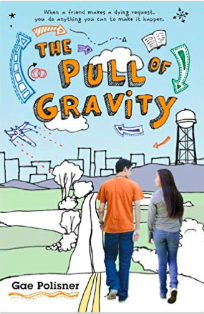 BRIDGING THE GAP BETWEEN THE PULL OF GRAVITY AND OF MICE AND MEN: People often ask why I incorporated John Steinbeck’s Of Mice and Men into my contemporary young adult novel, The Pull of Gravity. The short answer is that it was part intention, and part serendipity.The Pull of Gravity follows teens Nick Gardner and Jaycee Amato who, armed only with the wisdom of Yoda, a rare first-edition copy of Steinbeck’s Of Mice and Men, and the vaguest of plans, embark on a secret road trip to try to keep a promise to the Scoot, their dying friend.
BRIDGING THE GAP BETWEEN THE PULL OF GRAVITY AND OF MICE AND MEN: People often ask why I incorporated John Steinbeck’s Of Mice and Men into my contemporary young adult novel, The Pull of Gravity. The short answer is that it was part intention, and part serendipity.The Pull of Gravity follows teens Nick Gardner and Jaycee Amato who, armed only with the wisdom of Yoda, a rare first-edition copy of Steinbeck’s Of Mice and Men, and the vaguest of plans, embark on a secret road trip to try to keep a promise to the Scoot, their dying friend. With the words “vaguest of plans,” those familiar with Of Mice & Men will already recognize a glaring connection between the works: In both stories, plans go awry, and, in the course of the unraveling, Nick and Jaycee (like Lennie and George) learn some valuable, if at times painful, life lessons.
Intention vs. serendipity.
When I started writing The Pull of Gravity, I knew first and foremost that I wanted to write a character-driven piece, the ilk of which I read as a kid from the likes of Zindel, Blume, Konigsburg. To me, character-driven means that the characters are *the* reason you want to know the story, and not the other way around, with the plot driving the story. As Nick and Jaycee formed on the page, I thought, ‘how better to see if Jaycee is as persuasive and intriguing as I want her to be (and the chemistry between the two teens as real as I hope), than by seeing if she can *sell* the merits of an often-taught work of classic literature to Nick, a 15-yr old boy.’ Hence, the muse-driven idea of incorporating a classic novel into my debut was born.But which piece of classic literature to choose? That is where intention factored in, and the connections between The Pull of Gravity and Of Mice and Men began to take shape.
With the words “vaguest of plans,” those familiar with Of Mice & Men will already recognize a glaring connection between the works: In both stories, plans go awry, and, in the course of the unraveling, Nick and Jaycee (like Lennie and George) learn some valuable, if at times painful, life lessons.
Intention vs. serendipity.
When I started writing The Pull of Gravity, I knew first and foremost that I wanted to write a character-driven piece, the ilk of which I read as a kid from the likes of Zindel, Blume, Konigsburg. To me, character-driven means that the characters are *the* reason you want to know the story, and not the other way around, with the plot driving the story. As Nick and Jaycee formed on the page, I thought, ‘how better to see if Jaycee is as persuasive and intriguing as I want her to be (and the chemistry between the two teens as real as I hope), than by seeing if she can *sell* the merits of an often-taught work of classic literature to Nick, a 15-yr old boy.’ Hence, the muse-driven idea of incorporating a classic novel into my debut was born.But which piece of classic literature to choose? That is where intention factored in, and the connections between The Pull of Gravity and Of Mice and Men began to take shape.
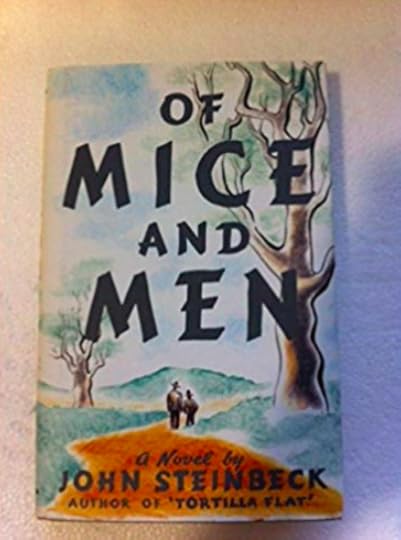 Why Of Mice and Men?
The main reason I chose Of Mice and Men was for the theme of friendship that reverberates through it. Indeed, the ending of Of Mice and Men may contain the ultimate act of friendship to be found in modern literature. Likewise, friendship is the main theme in The Pull of Gravity. Nick and Jaycee need each other, and their friendship buoys them through a time of change, heartache and pain.I’ve also attempted to keep some structural similarities between the pieces. Of Mice & Men is a short work of fiction – a novella at 107 pages. George and Lennie’s story takes place over a mere four days. They set out on a Thursday and the story concludes on a Sunday.While The Pull of Gravity is a longer work at 208 pages, the time frame of the story is brief, and the main part of Nick and Jaycee’s journey, to wit, their time in Rochester, NY, also unfolds Thursday through Sunday.When I go into classrooms, I love to talk to students about how Steinbeck was able to create so much empathy for, and connection to, his characters in the space of so little time (and so few words) – the reader gets to know George and Lennie and, more importantly, to care about them, in not much more than a mere breath.
Why Of Mice and Men?
The main reason I chose Of Mice and Men was for the theme of friendship that reverberates through it. Indeed, the ending of Of Mice and Men may contain the ultimate act of friendship to be found in modern literature. Likewise, friendship is the main theme in The Pull of Gravity. Nick and Jaycee need each other, and their friendship buoys them through a time of change, heartache and pain.I’ve also attempted to keep some structural similarities between the pieces. Of Mice & Men is a short work of fiction – a novella at 107 pages. George and Lennie’s story takes place over a mere four days. They set out on a Thursday and the story concludes on a Sunday.While The Pull of Gravity is a longer work at 208 pages, the time frame of the story is brief, and the main part of Nick and Jaycee’s journey, to wit, their time in Rochester, NY, also unfolds Thursday through Sunday.When I go into classrooms, I love to talk to students about how Steinbeck was able to create so much empathy for, and connection to, his characters in the space of so little time (and so few words) – the reader gets to know George and Lennie and, more importantly, to care about them, in not much more than a mere breath.
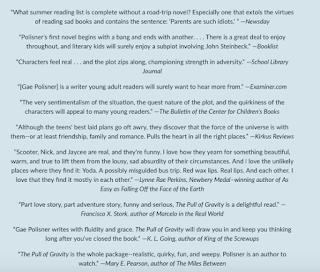 Similarly, Nick and Jaycee’s relationship unfolds quickly; they become important to one another – and, I hope to the reader— over a brief period.
Other Common Themes
- The American Dream (“Everybody Wants a Place of their Own”). Both The Pull of Gravity and Of Mice and Men deal with the desire to attain the American Dream: work that is bearable (if not more) and a small patch of land that feels like home. In The Pull of Gravity, Nick’s father is unable to attain this goal, to balance metropolitan career aspirations with his family’s move to the suburbs, which is one of the failures that spurs the main action of the book. Similarly, Jaycee is relegated to her mother’s new husband’s gaudy house, and, moreso, to the fluffy pink bedroom of the new husband’s daughter that will never feel like home.
Disability
. Of Mice and Men illuminates the prejudices suffered by Lennie because of his mental disability, but also the challenges for George, his friend, in trying to care for him. In The Pull of Gravity, the Scoot has a physical, rather than mental, disability, and while he doesn’t suffer the direct prejudices Lennie does, Nick – just like George with Lennie – grapples with his role as a loyal friend versus obligated caretaker. Of course, ultimately, his love and loyalty shine.Loss & Loneliness. The Pull of Gravity opens with this quote from Of Mice and Men:“Lennie broke in. ‘But not us! An’ why? Because…because I got you to look after me, and you got me to look after you, and that’s why.’ He laughed delightedly.”This quote epitomizes the friendship theme that resonates through both stories. Without each other, George and Lennie have no one. Similarly, Jaycee and Nick experience a lack of fitting in, connecting, feeling grounded in their own lives, until they find one another.Of course, the counters to friendship are loneliness and loss, and these themes also run through both stories. George and Lennie have suffered loss when we first meet them, and, once at the farm, there is the loss of Candy’s dog, of Lennie’s puppy, of Curly’s wife, and ultimately each other. In The Pull of Gravity Nick, Jaycee and the Scoot all suffer loss (whether temporary or permanent), of family structure, of innocence, and of friendship. It is a bond they have in common and that, ultimately, brings them closer together.*this 2011 essay written with the generous assistance of Paul W. Hankins.
Similarly, Nick and Jaycee’s relationship unfolds quickly; they become important to one another – and, I hope to the reader— over a brief period.
Other Common Themes
- The American Dream (“Everybody Wants a Place of their Own”). Both The Pull of Gravity and Of Mice and Men deal with the desire to attain the American Dream: work that is bearable (if not more) and a small patch of land that feels like home. In The Pull of Gravity, Nick’s father is unable to attain this goal, to balance metropolitan career aspirations with his family’s move to the suburbs, which is one of the failures that spurs the main action of the book. Similarly, Jaycee is relegated to her mother’s new husband’s gaudy house, and, moreso, to the fluffy pink bedroom of the new husband’s daughter that will never feel like home.
Disability
. Of Mice and Men illuminates the prejudices suffered by Lennie because of his mental disability, but also the challenges for George, his friend, in trying to care for him. In The Pull of Gravity, the Scoot has a physical, rather than mental, disability, and while he doesn’t suffer the direct prejudices Lennie does, Nick – just like George with Lennie – grapples with his role as a loyal friend versus obligated caretaker. Of course, ultimately, his love and loyalty shine.Loss & Loneliness. The Pull of Gravity opens with this quote from Of Mice and Men:“Lennie broke in. ‘But not us! An’ why? Because…because I got you to look after me, and you got me to look after you, and that’s why.’ He laughed delightedly.”This quote epitomizes the friendship theme that resonates through both stories. Without each other, George and Lennie have no one. Similarly, Jaycee and Nick experience a lack of fitting in, connecting, feeling grounded in their own lives, until they find one another.Of course, the counters to friendship are loneliness and loss, and these themes also run through both stories. George and Lennie have suffered loss when we first meet them, and, once at the farm, there is the loss of Candy’s dog, of Lennie’s puppy, of Curly’s wife, and ultimately each other. In The Pull of Gravity Nick, Jaycee and the Scoot all suffer loss (whether temporary or permanent), of family structure, of innocence, and of friendship. It is a bond they have in common and that, ultimately, brings them closer together.*this 2011 essay written with the generous assistance of Paul W. Hankins.
August 9, 2019
Maybe Your Students Need More Stories About Mental HEALTH
 (adapted from an article I wrote on Linked In)
(adapted from an article I wrote on Linked In)As we get ready to send our children, our adolescents, our teens and young adults, back into the classroom, it's time to think about those fall stressors, what each child is dealing with at home, in their personal lives, plus the pressures they face, perhaps, from the kid sitting next to them, or waiting for them down the hall.
Knowing this, knowing how many of our teens, especially, are suffering these days, many educators will encourage them to read books about mental illness. There are long lists of such books, many of them great, compelling stories, many award-winners, but how often I wish these stories reflected less about mental illness and more about mental HEALTH.In fact, IMHO, some of the most famous of these books seem to glamorize mental illness and/or suicide in problematic ways. In these stories, the adults are rarely helpful and rarely very present at all.
In the face of rising natural, and unnatural, disasters, there's an oft-quoted Mr. Rogers' line, "Look for the helpers," but so often in these stories our kids read, the helpers, quite frankly, just aren't very good. They really don't seem to care much. They don't have much skill.
 When I sign copies of STARS, I often include
When I sign copies of STARS, I often includea replica of Sister Agnes Teresa's ladder up.
Because who doesn't need a ladder up sometimes? I wondered why this was. . . and, as I wrote and shaped IN SIGHT OF STARS and realized my protagonist, Klee, was in a bad way and needed help, I wanted to present the other side, the side I have been lucky enough to experience -- from my high school guidance counselor who offered me a safe haven through all of junior and senior year, through some of the extraordinary therapists who have helped me and my family through some of our roughest times, their roughest times, as I raised my kids.

That is Dr. Alvarez, a character modeled largely on a real therapist, a true and extraordinary helper who patiently works with Klee until he is ready to participate in his own healing during his stay at an in-patient rehab facility in a fictional town in upstate NY.
Therapists can be like shoes -- it often takes several tryings on before you find one that fits, find one that is comfortable, the right size and style for you. But they are out there, and I'm hungry for them to be fully reflected in books for teens.

Similarly, I'm anxious for the use of psychotropic medications, where needed, to be positively reflected in young adult stories, which is to say, they don't change who a person is, or undermine their ability to be creative -- If they are, perhaps that person is on the wrong medication for them, or the wrong dosage. My experience with such medications is they simply allow the person to function more typically, as themselves, by quieting or taking the edge off atypical and problematic body chemistry.
In IN SIGHT OF STARS, Klee needs the help of medication for the time being, and may not need those medications in the near future.
 Yes, there is language in the story. YES, there are intense situations. Have you seen what our kids are privy to these days? Have you met any of our teens?
Yes, there is language in the story. YES, there are intense situations. Have you seen what our kids are privy to these days? Have you met any of our teens?Look, all I know is our kids need help and support ,and if you want them to feel safe seeking it out, share stories with them where the help HELPS. Because it can, and does.

I promise, it can and does.
- gae
August 1, 2019
Friday Feedback: Speaking my truth fearlessly, and asking you, How will YOU write forward?
"To tell the truth, Pop, there’s a whole slew of people missing points.
There are people busy condemning books they haven’t read.
And people trying to regulate who is allowed to write what." - Christopher Myers, 2019 Children’s Literature Legacy Award Acceptance by Christopher Myers on behalf of Walter Dean MyersA few years ago, writers, especially in the children's book market, started speaking out loudly. Calling out other writers. The underlying reasons were good. The initial motivation altruistic and important. We need diverse books. We need "own voices." Mostly no one debated this. At least not those in our industry. More importantly, mostly everyone wanted to help! Really! We chimed in. Amplified diverse voices. Shared diverse titles. And more. And yet.
IMHO, like with religion wherein the core of each is good, yet the interpretation of each has sparked nearly every war throughout history, the WNDB/OwnVoices movement -- and motivations? -- seem in some instances to have morphed, gotten bastardized. I can't really think of the right words.
I won't go into further detail. If you're paying attention to our industry, you already know what I'm talking about. Articles have been written. Books have been cancelled. Anger and righteousness have been spewed.
Anyway, Christopher Myers says it best up there, and right here:
"And Pop, don’t get me started on Twitter. You’d be amazed at the number of people who think they can say something nuanced and important andworth the time it takes to type it, in 280 characters. I don’t think they love language the way you taught me to,
at least most of them don’t."
What I will say is that, while trying to lift others daily, I spoke out against the anger, the delivery, and the platform. I spoke out against the calling out that sent good people spiraling, into actual despair (yes, even non-white authors) while also suddenly seeming to sell the books of the callers-out in the process (which, yes, troubles me). I also spoke out against subsets of "other" left woefully out of the diversity conversation, especially Jewish authors, and Jewish books, and yes this continues, and yes I can give you examples if you need them.As a result of speaking out (either on my private facebook page or a friend's private page), last summer I was essentially told I was tone policing (notable that I was only ever concerned with the behavior of either white writers or certain others who point blank told me they had zero duty of good faith) and asked to leave Teachers Write. I was told that despite (or notwithstanding) my politics, my day to day actions in voting, marching, protesting, donating, lifting others, and simply doing my best to exist as a good human, that I was "not on the same plane about representation," and thus not worthy of being a part of TW anymore.I decided last summer, when announcing it would be my last as part of TW, to gently share on my own blog here that I was not leaving my campers of my own volition.
In response, I was told not to speak about it, not to share my own truth, by a well-known children's book writer I barely know. Here's the DM I received:

Begging people to know my truth? Actually, yes, perhaps that feels important to me.
So, this is me, now, on my quiet little blog that almost nobody reads anymore, speaking my truth, because sometimes the truth will, in fact, set you free.
I didn't want to leave Teachers Write. I was asked to leave.
So, this is me saying farewell to this feature I started so many years ago, before Teachers Write, when my first book was bought by fsg.
Please know, I did try to continue Friday Feedback this summer. But, without the community I helped build, especially on facebook (the page there having been my initial idea -- and me having been the one to initially breathe life into it and maintain the interest there even in the off season, but having since been archived though I requested to keep it), there's just not enough activity here. We had cultivated over 2,000 followers there, and though a few hundred of you have joined me on the new Friday Feedback page I started end of last summer, it simply isn't enough to bring enough of you here each week to justify asking guest authors to write posts, or even for me to put in the time it takes to
 Me, on my computer screen, talking with my online
Me, on my computer screen, talking with my onlinenovel-writing class.put each blog post together. Especially at this time in my life when I'm juggling teaching in-person novel writing classes as well as online (ask me about this!); four manuscripts in various stages of writing/production; a dog who needs walks and attention; my kids (who need versions of the same ;) ); a very part-time law practice; weekly, if not daily, activism; household to-do lists, and, of course trying to yoga and swim. Whew!
YES, this makes me sad.
YES, I will miss it and all of you (though presume I will continue to see all my hard-cores elsewhere. . . )
So, that's that. I have NO further need to discuss it all, and request that you refrain from bringing it up the comments OR ELSEWHERE (though I get this is public and I'm really not going to be able to stop you). Look, as they say, it is what it is, I know who I am, and I am more than ready to move forward with new ventures.
But where to leave you all?
Us all.
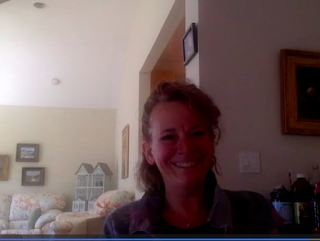 Happily, teaching online. :)
Happily, teaching online. :) I leave you with my sincere wish that you continue to write forward.
That you KEEP GOING.
That is all.
So, here's my question for you:
You've started something you love.
You've started something you might love.
You've started something you hate, but you've always wanted to write, and, heck, maybe you will love down the road.
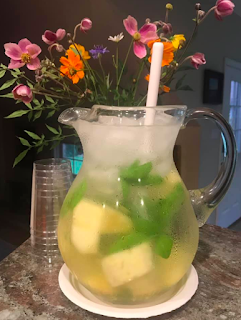 Here's the fancy water I serve to my in-person
Here's the fancy water I serve to my in-personnovel writing workshop students for inspiration!Or,
You've yet to start something, but you have always wanted to.
How will YOU write forward?
How will YOU carve out the time a few hours a week, to do what you love, to do what moves your soul, to tackle this item on your wish list? To be who and what you want to be?
I've said this over and over again, the time IS there. You have to carve it out. You have to make it, then TAKE it.
Here are a few thoughts I shared with my in-person novel writing group last night for when our weekly classes end in two weeks, and fall sets in and busy fall schedules ensue:
Pick two times per week that could work for you to write (say, Wednesday nights when you used to come here to class anyway, and Sunday mornings before everyone else wakes up. Tell your partner, your kids, your dog, this time is YOURS. That you're a writer. And that's what you will be doing during that time. Better yet, leave your house for the library, the local coffee shop, a park, the beach, etc. for those hours. Heck, sit in your car in the driveway if it's too late at night to go anywhere.
Engage in physical activity/see the world (or just around your local world). Sitting staring at a blank page or screen, especially when you're "stuck" will rarely get you going or inspired. Go for a swim, a bike ride, a walk. Go do something new you've never tried before. The world is full of endless inspiration. Write into yours.
So, how will you write forward? I'd love you to share your intentions in the comments, along with your excerpt for feedback.
Now, without further ado, let's Friday Feedback. You know the rules (but in case you don't, read them here: THE RULES).
Here's another excerpt from an adult manuscript I'm working on. A few weeks ago, you saw Paul. This is a glimpse of his wife, June.
Looking forward to reading yours.
Twenty years after.
June
June Sobel sits at the living room window, across from the piano, and stares out at the patchy lawn. She’s not thinking about the small lump her OBGYN found in her breast yesterday morning, or the biopsy she has to go in for next week. She’s thinking about Gabriel and the time he explained chord progressions to her, a moment that comes back to her lately, again and again.
“Since there are only so many chord progressions to choose from,” he’d told her, “you can’t protect them, or accuse other people of stealing them.”
He’d been sitting at the piano, then, absentmindedly fiddling with the last two high-pitched keys, to the point where she’d lost her patience, annoyed at the repetition. It infuriated her, the way he’d do that, play nothing at all, or worse, something aggravating just to get on her nerves, when he was more than capable of playing something beautiful.***
Thanks for sharing along all these years.
And an especially huge thank you to all the guest authors!!!
With love and affection,
Gae
July 26, 2019
Friday Feedback with Sarah Aronson: Top 5 things about writing picture books—even if you think you are a novel writer.
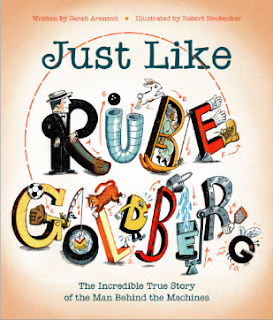 I was especially excited for the release of Sarah's awesome new picture book, JUST LIKE RUBE GOLDBERG, because, from a young age, my parents taught me about him, and his name became like Kleenex-for-tissue in our house, a two-word description for anything that was deliciously eccentric, complicated, or complex. Here's a brief description for the book!
I was especially excited for the release of Sarah's awesome new picture book, JUST LIKE RUBE GOLDBERG, because, from a young age, my parents taught me about him, and his name became like Kleenex-for-tissue in our house, a two-word description for anything that was deliciously eccentric, complicated, or complex. Here's a brief description for the book!Discover how Rube Goldberg followed his dreams to become an award-winning cartoonist, inventor, and even an adjective in the dictionary in this inspiring and funny biographical picture book.
See? An adjective!! Yes!! Just like he was in our house!!!
So, please check out this -- and her other books, order a copy for your classroom or kids, and ask your local library to order it in if they haven't already. A worthy title for any and all collections!! And now, without further ado, here's Sarah, who, I think, expands on the concept of finding the joy and play in our work as we go along we started talking about last week, and then shares FIVE awesome tips for picture book writing:
Hey there! My name is Sarah, and I like to write in multiple genres.

I didn’t think it was going to be this way.
A couple of years ago, after two YA novels and a MG novel, I took the dramatic (at least to me) step to try and write the genres I didn’t think I was good at. I have talked about this decision a lot over the years. Mostly because it changed my career. And made me a happier writer. But at the time, I didn’t know what was going to happen. All I knew is that my third book sold poorly. My fourth book didn’t sell.
I was having less fun.
I needed to get out of my own way. To learn to play. To be like David Bowie. To embrace the creative life all over again. To think less, write more.
And did I say have more fun?I really wanted to have more fun.
During the next six months, (and ever since) I totally indulged myself. And it worked. I wrote The Wish List Book One: The Worst Fairy Godmother Ever.

 I started an adult novel (that I still have to finish). I wrote a bunch of picture books—some awful. Some didactic. Some pretty good. One of them came like a spark of inspiration. It became Just Like Rube Goldberg—which was published by Beach Lane Books with GORGEOUS illustrations by Robert Neubecker.
I started an adult novel (that I still have to finish). I wrote a bunch of picture books—some awful. Some didactic. Some pretty good. One of them came like a spark of inspiration. It became Just Like Rube Goldberg—which was published by Beach Lane Books with GORGEOUS illustrations by Robert Neubecker. The process of making that book taught me a lot. More than five things. But today, let’s talk about the top five things about writing picture books—even if you think you are a novel writer.
#1 Let’s start with the thing everyone talks about when they talk about picture books:
WORD COUNT!Here is what I learned right off the bat: Short word count is not a demotion. It is a challenge to get to the heart of the story. To embrace THE FORM.
A short word count helps create better pacing. (Don’t you hate it when you are ready to turn the page for a new illustration, but there are still more words to read???) Remember: picture books (like all books) are cinematic. But unlike novels, they are driven by and inhabited through the pictures. Although the words come first in the submission process, the words cannot interfere with the illustrations.
When I saw Robert’s illustrations taking shape, I deleted words.
Now when I work on my picture books, whether fiction or true stories, I try to make them as short as possible. Because words you don’t need are…well…words you don’t need.
#2YOU HAVE TO FEEL CONNECTED TO YOUR SUBJECT. Or in other words: you have to love what you are writing.Or in other words: your heart must be in your story.
Just like Rube Goldberg is all about Rube. But it is also all about ME. It’s about my ideas about creativity—that are embraced by Rube’s. Every second of the process was FUN. Even when I was frustrated with my own limitations, I was enjoying playing with the words.
If you are not having fun…If writing is not feeling like ice cream…If you are making decisions because of THE MARKET. Or BECAUSE SOMEONE TOLD YOU SOME RULE. Stop.
Start a new page.Find your heart in the process.(You will thank me later.)
#3Writing a true story? BACK MATTER MATTERS. Back matter isn’t just a chance to show off how much research I did. Back matter marks the spot where curiosity met process. (Not for nothing, editors like to see that you did your work.) TRUE STORY: when I was researching Rube, I actually found ANOTHER STORY. But mostly, thinking about back matter made me think more about my reader. There was a lot more I could have shared. I created back matter and a bibliography knowing that my readers would be curious, too. I want them to keep learning after they are done reading, since the book couldn’t be about everything. Note: I will be on a panel talking about this at NCTE. Come say hi!
#4 TAKE THE TIME TO MAKE THE DUMMY.See your story on the page.Draw bad drawings.Read your book and turn the page. My first Rube Dummy showed me where I needed to show more.The dummy I just made for my new secret project which I cannot announce yet (Shhhhhhhhhhhhh), showed me where I was overindulging and writing too many words that I did not need. When I cut those words, THE BOOK SOLD.
LAST and MOST IMPORTANT:
#5TRUST and CONFIDENCE are ESSENTIAL.
Just like any project, you have to trust yourself. You have to trust your reader friends.You have to trust your agent.You have to trust your editor. You have to trust your illustrator. It’s a lot of trust.And I will admit: I am bossy. I had ideas for Rube. BUT NONE were as good as this:

So that’s it.Five things.In less than 1000 words.

And, now, I guess it's my turn to put my words where my mouth is and offer up a brief excerpt for your feedback, inviting you to do the same in the comments!
If you've never participated in Friday Feedback, please first read THE RULES!!!
Here is a piece of a picture book WIP I am working on. I'm actually about to submit it.
It's called As Easy as 1 2 3.
Who is the most exhibited artist in the world? Would you believe Picasso?Or maybe Monet?Or how about Dan Robbins?
Never heard of him? Pull up a chair.
Dan Robbins worked at Detroit’s Palmer Paint Company in early 1950. His Boss, Max Klein, could see the writing on the wall. For the first time, Americans had the time, inclination, and money to take up new hobbies—including art.
He asked Dan to create a coloring book—to drum up sales of children’s paints.
But Dan had a better idea.
He knew that the great master, Leonardo da Vinci, taught his apprentices to create fine art by giving them numbered patterns.
Each number on the canvas corresponded to a unique pigment.
Like 1 for red.And 2 for yellow.
Dan figured if it worked for Leonardo, it could work for America, too.
---
So that's it! Looking forward to your comments and your excerpts!!!
Sarah (& Gae)
July 19, 2019
Friday Feedback With Lori Landau: Play With Your Art and Other Downward Dog Epiphanies

"How do flowers experience life?
What do humans have in common with birds, or water or grass?
How does the body carry and interpret consciousness?"
These questions opened the draft blog post of my guest host, my amazing friend Lori Landau. The rest of the post is coming to you, soon, below.
But first a bit about Lori.
Her poetry, essays and articles have been published in books, magazines, and online, and she has shown her art in a variety of venues in the tri-state area.
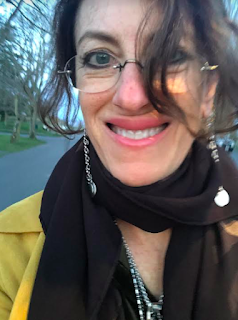 My full of love and light friend. . .
My full of love and light friend. . . In addition, she's a certified yoga and meditation teacher, and offers experiential writing workshops that are deeply inspired by her connection to poetry, spirit, and elemental materials like water, earth, branch and stone.
She's also currently an MFA candidate in Interdisciplinary Arts, and is working on a book about contemplative creativity.
Whew!!!
I have known Lori since we were young (young) adults, have always admired her art and poetry, and have even featured her at least a few times, like here, on my blog.
But with all that said, she's never hosted Friday Feedback before.
Then, a few weeks ago, we were out to dinner with my family. My husband, who is a beautiful singer, was lamenting how he doesn't really sing very much any more. He gave her a bunch of lame reasons that made me sad. I backed away from the conversation, it being one he and I have had before.
Then Lori asked him, "When was the last time you just enjoyed it all? Played with your music? Had fun with your craft?"
The question was so pure and simple and perfect (and different than anything I would have come up with to say to him), it got me thinking how wonderful it might be if she pursued the thought a little bit more here. With me, her and YOU.
So without further ado, and springing off from her above three questions that opened this post, here she is. Lori Landau:
 Daily Drawing PracticeRilke advised the young poet to “live the questions.” I read that line when I was seventeen, the same year that I had my first poem published (in Seventeen magazine). From an early age I experienced life as a series of mysteries and the questions themselves have become a part of my cellular being, and my creative practice which is writing and making art.
Daily Drawing PracticeRilke advised the young poet to “live the questions.” I read that line when I was seventeen, the same year that I had my first poem published (in Seventeen magazine). From an early age I experienced life as a series of mysteries and the questions themselves have become a part of my cellular being, and my creative practice which is writing and making art. I have written poems, essays and made art since I was a teen. (Including trading poems with Gae, who wrote gloriously even before she graduated high school). In my attempt to be the best I can be, I have studied art, writing, yoga, meditation, Buddhism, and countless other things all in an attempt to learn as much as I could about myself and my crafts, and still I struggled.
I was the quintessential, perfectionist procrastinator, better at distracting myself or making myself wrong than actually sitting down to do what I loved.
I was the quintessential, perfectionist procrastinator, better at distracting myself or making myself wrong than actually sitting down to do what I loved.That is, until I realized that in trying to be perfect, I was going about it all wrong. I was losing out on what I loved best about making art and writing: the process of discovery.
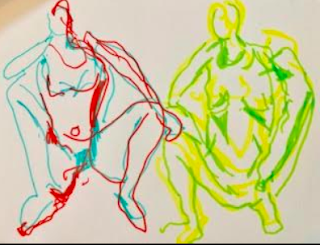 Daily Drawing Practice
Daily Drawing PracticeThat’s when I began to apply all of those meditation lessons and downward dog epiphanies to my writing. I realized, if I want to write and make art without all the pressure I was putting on myself, I would have to make it fun.
Remember fun?
It’s hard to allow ourselves to cultivate a sense of play in our culture which puts a high value on productivity.
My tutelary spirits. . . have all given me ideas for how to put the emphasis on process rather than product.
But my best work happens when I can get out of my own way and just do what I love. Making my art and writing fun means getting curious about myself, and about the craft of writing and art. I study how other writers and artists create, by regularly reading the work of my tutelary spirits. John Cage, Jenny Saville, William Kentridge, Lao Tze, Ryokan, David Hume, Martin Heidegger, Anselm Keifer, Bell Hooks, Yoko Ono, John Berger, Twyla Tharp, Mary Oliver, Walt Whitman, have all given me ideas for how to put the emphasis on process rather than product.
Now, I bring a sense of exploration to my own practices. I am deeply fascinated with how elements like chance and intuition affect the creative process. Focusing on that fascination means allowing myself to try things without an expectation for a fantastic outcome.
I have found that allowing myself to just enjoy what I am doing yields much better results than over-efforting.
For instance, if I want to draw a portrait and don’t like the way it is coming out, I try drawing it with my left hand (I’m a righty) in order to unleash the intuitive mind. If I can’t come up with a brilliant poem or paragraph, (yes, I do still struggle with perfectionism sometimes), I set a timer and “free write” for 15 minutes. I have found that allowing myself to just enjoy what I am doing yields much better results than over-efforting.
One practice that really works for me is to make a drawing or write a poem as soon as I wake up. I make it a daily ritual to “gift” myself 20 minutes to draw or write while drinking my first cup of coffee. Admittedly that was harder when my kids were little, so eventually I figured out how to find little pockets of time to draw, such as when I sat in the car on the pick-up line at school.
A large part of my practice is wandering, literally and figuratively. I let myself daydream, I carry a journal everywhere I go and write ideas down when I have them, and I get myself outside as much as I can. I believe we mirror nature, so I find it helpful to get as close to the trees and water as possible. The more I see myself through the lens of a larger world, the more connected I feel to myself and that world, and the easier it is to create.
For me, finding a sense of fun also requires slowing down. My practices allow me to question myself. I regularly tune in to figure out what my subtle body is asking for. Sometimes all I need is a deep, full breath to get going. Other times I have to discipline myself to stick to my intention and creative routine before I get to the fun part. Finding the fun in any kind of creative practice is itself a practice that like anything else, gets easier over time.
Can you remember when you just purely loved writing? How can you change the way you think about writing so you can bring a sense of wonder and enjoyment to what you do?
 Daily Drawing PracticeCan you remember when you just purely loved writing? How can you change the way you think about writing so you can bring a sense of wonder and enjoyment to what you do? Today I’d be so curious to read a passage that was fun for you to write. Maybe you can try something new. If you usually write fiction, try your hand at a poem or a free write about something you love. No matter what you choose to share (or not), bringing a sense of play to your writing will free up your imagination. You might even surprise yourself.
Daily Drawing PracticeCan you remember when you just purely loved writing? How can you change the way you think about writing so you can bring a sense of wonder and enjoyment to what you do? Today I’d be so curious to read a passage that was fun for you to write. Maybe you can try something new. If you usually write fiction, try your hand at a poem or a free write about something you love. No matter what you choose to share (or not), bringing a sense of play to your writing will free up your imagination. You might even surprise yourself.The passage I’d like to share with you here is a living example of a piece of work that was really hard for me, until I allowed myself to just have fun with what I was writing. It’s an excerpt from a book that I am working on about consciousness and creativity. It is a book of poems, artwork and critical writing. I’ll be checking in all day to read your excerpts and comment. I always find it an inspiration to see what others are working on.
And, remember, if you're not familiar with the RULES please read them there first!
----
“The unpredictable arithmetic of being human means that at any moment something can be added, subtracted, multiplied or divided from us. That’s why the great sages teach us to cultivate practices that help us let go of our attachments and find the middle way. The middle way allows us some flexibility, and the ability to be intimately “present.”
In viewing our endless balancing act as opportunity, we can step out of our conditioned perspective that tension in relationship is a problem. In doing so, we create a small space between emotion and reaction, and in that space we can empower ourselves to make choices that serve both ourselves and the other.
Being willing to co-exist in the moment-to-moment fluctuations of relationship creates openings through which we can more deeply experience how intricately we are tied to everything and everyone else. All of the things that exist as form, the body, with its blood, bone, veins, the natural world consisting of trees, grasses, clouds, water, soil, stone shapes us. Form is what makes essence visible.
-----
To connect further with Lori, you can follow her at @LoriElleLandau on Instagram, where she often posts her drawings, or a small slice of life. You may also email her at Jesart@aol.com
July 12, 2019
Friday Feedback with my BVFE Amy Fellner Dominy: Writing as Your Best Self
Happy Friday, all,
If you've been to Friday Feedback summers past (or are a fan of great realistic YA, MG, AND adorable laugh out loud picture books), you are no stranger to my Best Virtual Friend Ever (okay, okay, we are also friends in real life but we took on the title before we ever met!), Amy Fellner Dominy.
I love Amy's writing and stories, and I have learned so much from her over the years. So without a big unnecessary lead in from me, just know you are in awesome hands today.
Heeeere's Amy:
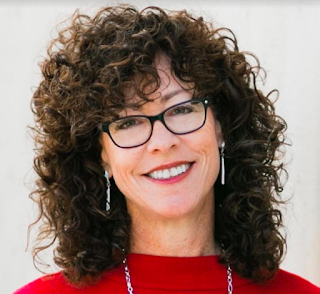
I’ve been trying to write like someone else since I was twelve.
That’s when I wrote my first novel, Thomas and the Tunnelworms. It was a direct rip off of Roald Dahl’s James and the Giant Peach. Dahl wrote widely inventive tales with oddball characters and a wacky humor that I loved and absolutely could not replicate.
You’d think I would learn, right? But no.
As I grew older, I fell in love with Tolkien and tried to write epic fantasy.
Epic fail.
I fell in awe with the world building of sci fi and dystopian novels. I read Kristin Cashore’s Graceling series and decided to create my own universe with beautiful maps and topography.
I can’t even read a map.
There were also attempts at poetic, lyrical writing over the years. Countless times when I would set down a literary novel and pick up my laptop trying to channel beauty through my short, stubby fingers. (Including, by the way, every time I read one of Gae’s novels.)
No go.
A few years ago, I read Gone Girl by Gillian Flynn and decided that I, too, could write twisty plots that would make reader’s gasp in shock.
Turns out, not so much.
Mysteries and spy thrillers were also attempted with the same results.
I finally came to my senses this year and I owe it to Delia Owens’ Where the Crawdads Sing. The descriptions of the setting are so beautiful I wanted to craft something one tenth as perfect.
And it hit me that I never would. Writing descriptive passages has never come easy for me—no matter how much I’ve worked on it over the years. So why was I spending so much energy and time over the years trying to match the strengths of other authors—and failing. Maybe what I needed to do was to figure out what I’m good at.
The truth is we all have strengths and weaknesses. The trick is figuring out what they are and building on our writing strengths while minimizing our weaknesses.
Here’s what I discovered about me:
Weaknesses (Things I struggle to write): World building. Lyrical writing. Poetry. Intricate plots. Large casts. Fantasies. Descriptions.
Strengths (Things I like to write): Contemporary stories. Realistic fiction. Teen stories. The emotional, inner musings of characters. Dialogue. Humor. Romance. Small casts.
So, what if I wrote a book and focused on my strengths? I could write about the inner world of a few characters and their conflicts. I could sprinkle in a few laughs and a few kisses. I could have a ton of dialogue and never tell you what a single sunset looked like.
And that’s exactly what I did with Announcing Trouble, my newest book that hits shelves on August 5th. It was the most fun I’ve had writing in a very long time. Announcing Trouble is a contemporary teen story full of romance, humor and heart. And along with teen books, I’m also writing funny picture books that are all dialogue.
Finally, I’m measuring up to the highest ideal of them all: My best self.
☺
Now it’s your turn to ask yourself the same questions. What do you most like to write? Where do your strengths lie? Here’s a simple way to help you figure out the answer:
When you look through your WIP, what is your favorite scene and why?
It just might reflect a strength of yours.
Today, I’d love you to share that passage with the rest of us. Also, tell us why it’s your favorite—why was it fun to write? Is there a truth in there you can build upon in your own writing? We all admire other authors and that’s a great thing. But it’s when we allow our own unique strengths and voice to shine that we do our best work.
 So here’s the scene I’d like to share with you. It’s a passage from Announcing Trouble. First a little about the book:
So here’s the scene I’d like to share with you. It’s a passage from Announcing Trouble. First a little about the book: I may know everything there is to know about baseball, but that doesn’t mean I have to like it. Or like him. Garrett Reeves: sidelined player and the embodiment of everything I’ve learned to hate about baseball. He’s gorgeous, he’s cocky, he’s laser-focused on getting back in the game, no matter the cost.
When he convinces me to call games alongside him, our chemistry heats up the booth. We’re good together, whether I want to admit it or not. I’m finding that I like baseball again, but even worse, I’m liking Garrett. A lot.
But when he has to decide between our future and a new shot at his dreams, I know baseball will win out every time.
Disclaimer: This Entangled Teen Crush book has tons of hilarious banter, lots of sexual tension, and a hero who will throw a wild pitch right at your heart.
(And, Amy won't say it, so I will! Please preorder Announcing Trouble and/or check out all of Amy's other wonderful books!!)
And now, here's my scene for feedback (if you're not familiar with the RULES please read them there first!):
“We can win this thing, Walters. I mean, how can we lose? I’m charming and insightful, and you understand the nuances of the game. Plus, you’re a girl.” I blink in disbelief. “That’s what I bring to this team? I’m a girl.” “It’s a bonus. Sets us apart. How many others will have a girl who knows her shit the way you do?” His head tilts as he studies me. “Especially one who’s so pretty.” My jaw drops. “Am I supposed to be flattered? Because that’s incredibly sexist, not to mention patronizing and...” “Demeaning?” he adds helpfully. He laughs. “It’s just an observation. Right now our camera is fixed on the field, but there might be opportunity for video, too. And you have nice eyes. Except when you frown and you get these weird slash marks between your eyes.” He points. “Yeah. Like those. I love the vintage tees, but your sandals are hideous. We’ll cut those out of our publicity photo.” “Publicity photo?” “We need to submit it with our game tape.” It’s all I can do not to scream. “There is going to be no game tape. I’m not saying yes.” “Because I don’t like your sandals?” “Leave my sandals out of this!” “That’s my point exactly.” His eyes gleam. “See, we’re already in agreement.”
Looking forward to reading your excerpts in the comments!
- Amy (and gae)
p.s. If you’re interested in reading more, the first chapter is available on my website: amy@amydominy.com. You’ll find it HERE. I’m also starting a monthly newsletter with giveaways, excerpts and book news. If you’d to sign up, let me know in your comments. My mailing list isn’t quite set up yet, but I can add you myself. ☺ Thanks so much to Gae for hosting me today. And thanks to you all for taking time to read this. I hope you’ll share an excerpt, too! I’ll be checking in all day and I’d love to read what you’re working on.



